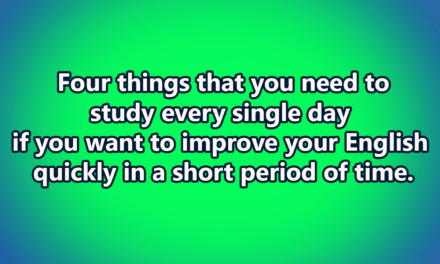Public speaking is daunting for most people. It’s commonly cited as the number one fear about snakes, above spiders, and above heights. Now, presenting in a foreign language is even harder and the chances are if you want to work in a multinational company, you’ll have to present at some point. Public Speaking needs some key tips for presenting clearly & confidently. We are going to give you some key phrases that you can use to fill in the gaps for Public Speaking. Additionally, We will help you to develop your Public Speaking techniques so that you can look & sound like those successful people you see giving Ted Talks. Let’s get started with the lesson:
i. To use set phrases to fill gaps: Firstly, let’s discuss some key phrases that you can use.
The first topic is greeting your audience. You can say,
- Good morning,
- Good afternoon or
- Good evening.
You can also say, welcome to and then the name of the event.
First, let me introduce myself. I’m (your name) from my company (name of your company).
⇒Beginning your presentation: let me start by giving you some background information…. or as you are aware…. If you’re bringing up a topic that your audience already knows about then you can use this phrase to introduce it. For example, as you’re aware that the product is available in three countries.
⇒Transitioning to the next topic: Before you move on to your next point, make sure it’s clear to your audience. For example, let’s move on to our next key point or turning our attention now to the results of our market research.
⇒Providing more details: I’d like to expand on. For example, I’d like to expand on my point about the fall in GDP. You can also say, let me elaborate further.
⇒Linking another topic: As I said at the beginning. You can use this one to remind your audience about a point you made earlier. It can also be used for emphasis. For example, as I said in the beginning, we might have a crisis on the horizon. The same goes for this relates to what I was saying earlier or this ties in with.
⇒Emphasizing a point:
- The significance of this is, or
- this is important because, or
- we have to remember that.
⇒Marketing reference to information:
- Based on our findings, or
- Our data shows, or
- According to our study.
⇒Explaining visuals: I’d like to illustrate this point by showing you, or this is chart shows a breakdown of…… A breakdown is often used in a presentation to show all of the smaller parts of something bigger.
⇒Repeating your point: These phrases are useful for emphasis and helping your audience to remember and understand what you said.
- In other words…..
- To put it simply……
- What I mean to say it…….
⇒Concluding your presentation:
- In conclusion……
- Let me sum up the main points…
Thank you for your attention. I’m happy to answer any questions you might have.
ii. Slow down: The number one tip I can give you especially if English is not your first language is slow down. When we get nervous we tend to speed up. If you combine this with an accent that the audience isn’t used to you, the audience will struggle to understand you. This is especially important at the beginning of any speech. You need to give them a bit of time to get used to how to speak.
iii. Use pauses to your advantages: Pauses are so useful. They give us time to process what is said. After saying something impactful I always leave a couple of seconds for the audience to process it. Use this pauses to give yourself time to think and time to have a break. Use them instead of saying um which can sound unprofessional. The best speakers make the audience think that the pause has been included for their advantage when in reality they just needed to take a second to consider what they’re going to say next.
iv. Do not apologize for your English: Now, this is controversial and I’m not going to say that you should never say this but definitely reconsider saying it. More often than not when I watch a presentation delivered by someone who isn’t a native English speaker, they will start their presentation with sorry for my English. I personally don’t like this. I think they’re doing themselves a disservice. They could take so much more control over the situation. Why not try saying something else like, “English isn’t my first language, but I’m going to try my best.” Instead of seeming unconfident and nervous and embarrassed, you’re talking ownership, you’re dealing with your circumstances.
v. Practice but don’t learn: You can 100% tell the difference between somebody who’s delivering a presentation naturally and somebody who has learned a presentation word for word. A practice presentation is organic and trustworthy it flows. A learned presentation is rigid, memorized, and a bit stagnant. It doesn’t matter if your presentation is ever so slightly different each time you practice it.
vi. Use your cue-cards to your advantage: If you’re allowed to use cue-cards or speakers note you must have them. You might not actually need to use them in your presentation but consider them your insurance policy. If the worse comes to the worst and you get stuck or get stage fright, they will help you get right back on tract. Having them in your hand also might make you feel more confident. You never know when you’re going to be caught off guard.
vii. Body language: Think about your body language. Everyone is different but when I present I don’t like to walk around on stage. I’m very uncoordinated and it’s likely I will trip or stumble. I like to have my feet parts so that I’m steady. I’ve my cue-cards in one hand but I use both gesticulate and emphasis.
-
- Practice in front of a mirror.
- Think about your chest, is it puffed out?
- Think about where you look in the room.
- Do you focus on one person in the audience or do you flick around?
⇒Think about your nervous tics. Mine is touching my hair and stroking my ring or my thumbnail. Try not to do that. Film yourself delivering your presentation and work out what body language needs to stay and what needs to go.
viii. Dress for the part: If it’s smart causal I lean towards the smart side. Feeling smart makes you feel more confident. Iron that shirt, shine those shoes, and paint those nails if you’re so inclined. Have a small mirror on you to check your teeth and face if you know that you will have a camera on you.
ix. Watch you who want to sound like: Our final tip is to learn from the best. Watch a variety of Ted Talks and interesting speeches and consider which styles of delivery you like best. Find out more about the speaker and try to channel their confidence and delivery but don’t mimic it. You need to develop your own style. Being inspired is the best way to do this.
Right, that’s it for this lesson. If you have any more advice on how to improve your public speaking then please, comment down below.

Assistant Teacher at Zinzira Pir Mohammad Pilot School and College










